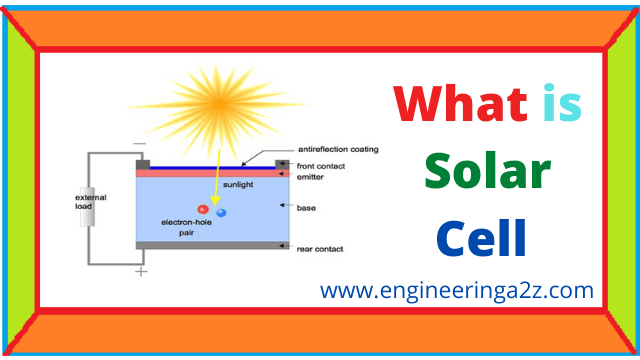
Table of Contents
Solar Cell
A semiconductor device that converts the energy of “Sunlight into electricity” is called a photo-voltaic cell or solar cell. The name photovoltaic cell comes from Greek word i.e.; photo means “light” and Volt is related to “electromotive force”. A cell generate electromotive force (emf) with the help of photo or light.

Construction of Solar Cell
Solar cell consists of pure silicon and an impurity silicon is doped with appropriate amount of acceptor impurity like Boron to N-type from the P-type semiconductor. The P-type layer is put at the top of photovoltaic cell. And N-type semiconductor is made by addition of arsenic or Phosphorus to intrinsic semiconductor and is kept at the bottom of PV cell. This two layers makes up P-N junction. Connecting leads are taken out from both P and N type layers forming the positive and negative terminal of cell respectively.

Working of Solar Cell or Photovoltaic Cell
When sun rays fall on the top of P-type semiconductor layer and penetrate into the lower N-type semiconductor material, these sun rays are absorbed by semiconductor material and generate the hole electron pair. Due to separation of charge carrier, an electric field is established. Current flow from P type material to and type material. Composition of solar cell is such that electrons are allowed to move in one particular direction only i.e.; from and type material to P type material.

For better understanding, a solar cell is illustrated in figure as shown below ; current source IL represent the solar cell output current. Current flow in solar cell is always from P to N type semiconductor. This flow of current is due to flow of majority charge carriers. This property of solar cell is represented by diode in parallel with current source as shown in figure. It shows that reverse current can’t flow through cell. However a reverse leakage current will flow as represented by IJ (IJ is junction current). R5 is represents the internal resistance of solar cell. IJ has very small value of leakage current and can be neglected.
V-I Characteristics of Solar Cell
Electric current produced by solar cell depends upon the intensity of solar radiation and area of cell exposed to solar radiation whereas generated voltage of a solar cell depends upon the type of semiconductor material used. The voltage of one solar cell is approximately 0.39 V. And current rating varies from 30 mA to 60 mA. To make a 12 volt solar plate we need to connect 30 to 35 cells in series.

Generation & Utilization of Solar Power
Generation and utilisation of electricity by solar cell is explain with the help of schematic diagram as shown in figure.

It Consists of :
- Solar Plate : Solar plate is a series combination of several solar cells or photo cells.
- Voltage regulator : Voltage regulator regulate the Solar output voltage i.e.; it maintains the solar voltage. In summer season, when light intensity increase, the heat radiation on solar cell plate also increases. It causes increase in the output voltage of the cell approximately 30 volt. But we need 12 volt to charge the battery. so, to maintain the output voltage as 12 volt we connect a voltage regulator at the output of solar plate.
- 12 v Battery : It is used to store electrical energy obtained from solar cell.
- Inverter : Output voltage of solar plate is DC. It is connected to battery for storage of energy to convert DC into AC we use inverter.
Application of Solar Cell
- Used in solar water heater.
- Used in solar furnace.
- Used in solar cookers.
- Used in solar water pumps.
- Used in solar lighting.
- Used in solar ponds.
- Used in solar still.
Frequently Asked Questions (FAQ)
What is solar cell?
Solar cell is a reciprocal device of LED. It converts the energy of light directly into electricity by the photovoltaic effect. It is essentially a large photodiode designed to operate as a photovoltaic device & to give as much output power as possible.
What are the types of solar cell?
There are four types of solar cell Crystalline silicon cells, Monocrystalline cells, Polycrystalline cells & Thin film solar cells.
How a solar is made?
Solar cell is made up of thin layers of Selenium or P-type material (0.002 to 0.006 Inch thickness) and thin layers of PV material on a supporting material such as glass, plastic, or metal.
What is the working of solar cell?
When the positive charge particle of light combines with the valance electron of either on P-type or N-type material. A energy is produced to leave the electron from its parent atom. Due to which electron and holes are generated on each side of junction which cause a voltage across it.
Read Also :





Comments (3)
Is there any solar plate with output of ac voltage??
Yes, but AC output solar plates are more expensive than normal solar plates.
This website truly has all of the information I needed concerning
this subject and didn’t know who to ask.